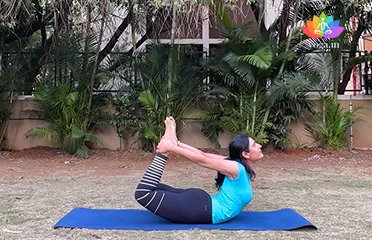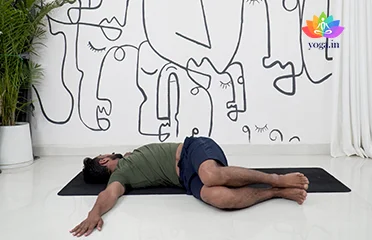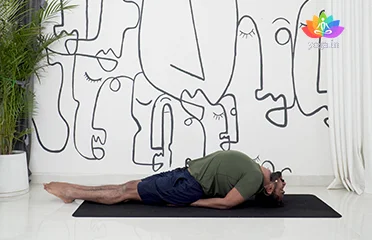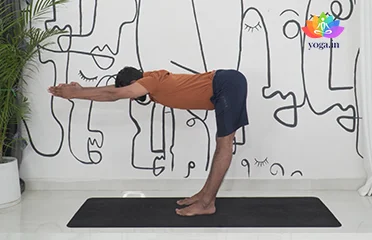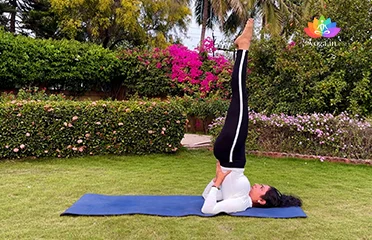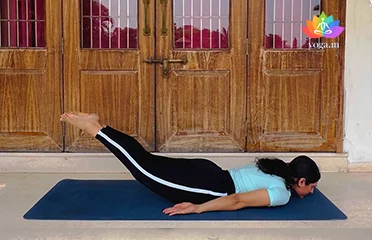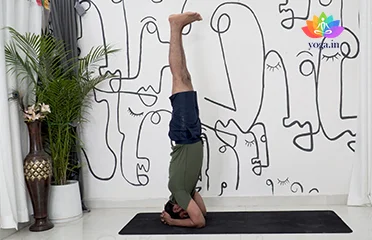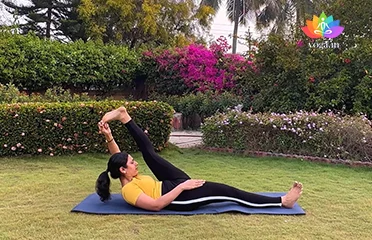Dhanurasana (Bow Pose)
धनुरासन / Bow Pose
The Sanskrit name is derived from Dhanur (धनुर) means bow and Asana [�K]
Jathara Parivartanasana (The Abdominal T
ञठर परिवर्तनासन / The Abdominal Twist
The Sanskrit name is derived from Jathara (ञठर) meaning belly or abdomen, [�K]
Matsyasana (Fish Pose)
मत्स्यासनI / Fish Pose
The Sanskrit name is derived from Matsya (मत्स्या) meaning fish [�K]
Samakonasana (The Right-Angle Posture)
समकोणासन / The Right-Angle Posture
The Sanskrit name is derived from Sama (समा) meaning straight, Kona meaning [�K]
Sarvangasana (Shoulderstand)
सर्वाङ्गासनI / Shoulderstand
The Sanskrit name is derived from Sarva (सर्वाङ्ग) meaning all, [�K]
Shalabhasana (Locust Pose)
सलभासन / Locust Pose
The Sanskrit name is derived from Shalabha (शलभा) meaning locust and [�K]
Sirsasana (Headstand)
शीर्षासन / Headstand
The Sanskrit name is derived from Sirsa (शीर्ष) meaning head and asana [�K]
Supta Padangusthasana (Reclining Posture
सुप्त पदंगुष्टासन / Reclining Posture
The Sanskrit name is derived from Supta (सुप्त) meaning 'supine or [�K]
How Yoga Can Help Cure Piles:
Piles, also known as hemorrhoids, are swollen veins in the lower rectum and anus. Yoga can be an effective method to manage and alleviate the symptoms of piles. By promoting better circulation, reducing stress, and enhancing digestive health, yoga helps in relieving the discomfort associated with piles.
Understanding Piles:
Piles are a condition where the veins in the anal and rectal area become swollen and inflamed, causing pain, itching, and sometimes bleeding. Piles can be internal (inside the rectum) or external (under the skin around the anus). This condition can be caused by factors such as chronic constipation, straining during bowel movements, and prolonged sitting.
Yoga’s Role in Relieving Piles:
Specific yoga practices can help alleviate the symptoms of piles by improving blood flow, reducing pressure on the anal veins, and enhancing overall digestive health. Gentle yoga postures, breathing exercises, and relaxation techniques can all contribute to the management and relief of piles.
Key Factors Contributing to Piles:
Several factors can lead to the development of piles, including:
- Chronic Constipation: Straining during bowel movements due to constipation can cause piles.
- Prolonged Sitting: Sitting for long periods, especially on the toilet, can increase pressure on the veins.
- Pregnancy: Increased pressure on the pelvic area during pregnancy can lead to piles.
- Low-Fiber Diet: A diet lacking in fiber can cause constipation and straining.
- Heavy Lifting: Frequently lifting heavy objects can increase abdominal pressure.
- Obesity: Excess body weight puts additional pressure on the rectal veins.
Symptoms of Piles:
Common symptoms of piles include:
- Pain and Discomfort: Painful swelling or lumps around the anus.
- Itching and Irritation: Itching in the anal region due to inflammation.
- Bleeding: Small amounts of bright red blood on toilet paper or in the toilet bowl.
- Swelling: Swollen areas around the anus.
- Mucus Discharge: Discharge of mucus from the anus.
- Difficulty Sitting: Discomfort while sitting due to pain and swelling.
Treatment of Piles through Yoga and Pranayama:
Yoga and pranayama can be highly effective in managing piles. Some beneficial practices include:
Specific Yoga Poses:
- Malasana (Garland Pose): Helps improve digestion and relieve constipation.
- Viparita Karani (Legs-Up-The-Wall Pose): Promotes blood circulation and reduces swelling.
Pranayama Exercises:
- Anulom Vilom (Alternate Nostril Breathing): Balances the mind and reduces stress, aiding digestion.
- Bhramari (Bee Breath): Calms the mind and reduces stress levels.
Diet for Piles:
A balanced diet can help manage piles. Recommendations include:
- High-Fiber Foods: Whole grains, fruits, and vegetables to soften stool and prevent constipation.
- Hydration: Drink plenty of water to stay hydrated and ease bowel movements.
- Probiotic Foods: Yogurt and fermented foods to support digestive health.
- Avoid Spicy Foods: Reduce intake of spicy foods that can irritate the digestive tract.
Caution for Piles:
While practicing yoga for piles, it is essential to:
- Avoid Overexertion: Practice at a gentle pace to prevent strain on the anal area.
- Be Mindful of Pain: Stop immediately if any pose causes discomfort or pain.
Always consult with a healthcare provider before starting any new exercise regimen, especially if you have severe piles.
Contraindications for Piles:
Individuals with severe piles or significant anal pain should:
- Avoid Intense Yoga Practices: Vigorous exercises might exacerbate symptoms.
- Steer Clear of Certain Poses: Poses that put pressure on the abdomen and rectal area may increase discomfort.
- Seek Professional Guidance: Consult a yoga therapist or healthcare professional for personalized recommendations.


